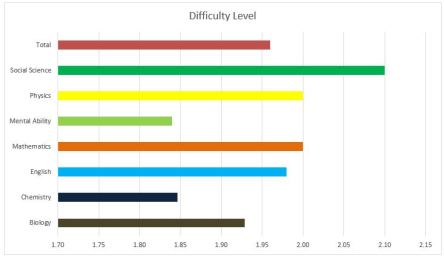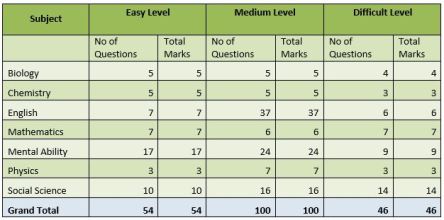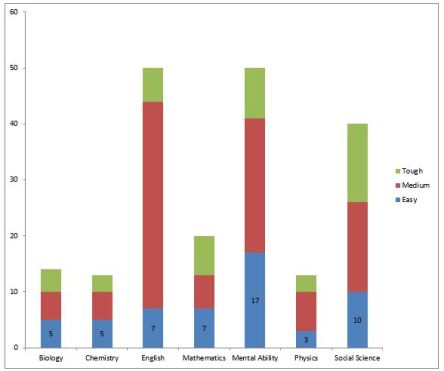NTSE 2016: The National
Talent Search Examination (NTSE) is a national level examination cum
scholarship program. The scholarship programme is conducted by NCERT and
students studying in class X are eligible for NTSE 2016
examination and selection procedure. NTSE stage-I was conducted on
November 7 in union territories and November 8, 2015 in rest of India
and was conducted on May 8, 2016 for Stage II.
Eligibility: As per the
eligibility criteria of NTSE 2016 all the students studying in X
standard are eligible to apply for this scholarship programme. A student
from any state of the country can register for this examination and
scholarship scheme. Whether a student is from a government or a private
school, he/she is eligible.
Pattern/ Syllabus: The
National Talent Search Examination is conducted for students studying at
the Class X level. The examination consists of two tests:
- Mental Ability Test (MAT)
- Scholastic Aptitude Test (SAT)
NTSE Mental Ability Test (MAT) Syllabus
This test is given to you to judge your
power of reasoning, ability to think, ability to judge, evaluate or
discriminate, ability to visualize in the space, spatial orientation,
etc. A variety of questions, for example – analogies, classification,
series, pattern perception, hidden figures, coding decoding, block
assembly, problem solving, etc. are used for this purpose.
NTSE Scholastic Aptitude Test (SAT) Syllabus (Language Test)
Language Test is designed to judge the
power of reading comprehension, logical sequencing; interpretative,
evaluative, predictive and creative components of language. The test is
conducted for English and Regional Languages.
NTSE Scholastic Aptitude Test (SAT) Syllabus (Maths, Science & Social Science)
This section is conducted to judge how
much of text-book knowledge you have gained. As India doesn’t has any
single unified board system, NCERT has not prescribed any particular
syllabus for the State Level Examination or for National Level
Examination.
You can expect questions that are asked at the National Level (Stage-II) to be standard of Classes IX and X level.
Question Paper: The
medium of test is English and regional languages and it comprised of 200
question. The students have to select and mark one right answer from
the four given options. Each right answer carry one point each, thus
making the total score of the candidate in a test equal to the number of
questions answered correctly. However, at the second stage 1/3 mark is
deducted for every wrong answer.
Merit Clause: All the
students who achieve requisite scores at this level automatically
qualify for scholarships that are handed over by NCERT.
Overall Marks Distribution
The NTSE 2016 Exam Pattern was an objective type test based on paper-pen format.
| Test | No. Of Questions | Maximum Marks | Time Allotted |
| MAT | 50 Questions | 50 Marks | 45 minutes |
| SAT – Language Test | 50 Questions | 50 Marks | 45 minutes |
| SAT – Maths, Science, Social Sciences | 100 Questions | 100 Marks | 90 minutes |

Overall Difficulty Level Analysis
In this analysis we have rated every
question on a scale of 1 to 3. The ratings are done by expert faculty of
Resonance. The individual ratings are then averaged to calculate
overall difficulty level.
- 1: Easy
- 2: Moderate
- 3: Difficult
| Subject | Difficulty Level |
| Biology | 1.93 |
| Chemistry | 1.85 |
| English | 1.98 |
| Mathematics | 2.00 |
| Mental Ability | 1.84 |
| Physics | 2.00 |
| Social Science | 2.10 |
| Total | 1.96 |

Difficulty Level Analysis: No of Questions

Resonance Experts feel that all subjects
were of similar difficulty level, while Social Science, Mathematics,
Physics, Biology and English were on tougher side, Chemistry, Mental
Ability were of moderate difficulty. While around 54 Marks can be
considered easy overall, 100 marks are moderately difficulty and 46
marks are considered difficult by Resonance Team.
Overall, it is felt by Resonance Faculty
Team that paper was on tougher side compared to last year but as the MAT
paper was easy, the cut-off is expected to be higher than that of last
year.
Question Wise Difficulty Breakup

Subject Wise Analysis
Physics Analysis
| Physics | |||
| UNIT & TOPIC NAME | NO OF QUESTIONS | TOTAL MARKS | (%) WEIGHTAGE |
| Physics | 13 | 13 | 100.00% |
| Electricity | 3 | 3 | 23.08% |
| Electric current, | 1 | 1 | 7.69% |
| Electric Field & potential | 2 | 2 | 15.38% |
| Fluid | 1 | 1 | 7.69% |
| Buoyancy and force of buoyancy | 1 | 1 | 7.69% |
| Force & Laws of Motion (NLM) |
1 | 1 | 7.69% |
| Principle of conservation of linear momentum | 1 | 1 | 7.69% |
| Light | 4 | 4 | 30.77% |
| Eye | 1 | 1 | 7.69% |
| Linear Magnification, Refraction through prism, | 1 | 1 | 7.69% |
| Refraction of Light, Laws of Refraction Index | 2 | 2 | 15.38% |
| Magnetic Effect of current & EMI |
2 | 2 | 15.38% |
| Electromagnet | 1 | 1 | 7.69% |
| Motion of charged particle in a magnetic filed (Lorentz force) | 1 | 1 | 7.69% |
| Motion | 1 | 1 | 7.69% |
| Motion in one, two & three dimensions | 1 | 1 | 7.69% |
| Work, Energy & Power (WEP) |
1 | 1 | 7.69% |
| Kinetic energy, Potential energy, | 1 | 1 | 7.69% |
| Grand Total | 13 | 13 | 100.00% |
Chemistry Analysis
| Chemistry | |||
| UNIT & TOPIC NAME | NO OF QUESTIONS | TOTAL MARKS | (%) WEIGHTAGE |
| Chemistry | 13 | 13 | 100.00% |
| carbon and its compounds | 3 | 3 | 23.08% |
| Introduction of organic chemistry, vital force theory, Wohler’s synthesis, Covalent bonding, Properties and examples of covalent compounds, | 1 | 1 | 7.69% |
| IUPAC Nomenclature , Isomerism | 1 | 1 | 7.69% |
| Soaps & Detergents | 1 | 1 | 7.69% |
| chemical reactions and chemical equations | 3 | 3 | 23.08% |
| General introduction of chemistry and chemical reactions, Characteristics of chemical reaction, Balancing of equations, Specialities & Limitations of chemical equation and their rectification, | 1 | 1 | 7.69% |
| Oxidation and reduction reactions, Effect of oxidation in our daily life – Combustion, Respiration, Pollution, Corrosion and Rancidity, | 1 | 1 | 7.69% |
| Types of chemical equations – Combination, decomposition, displacement and double displacement, | 1 | 1 | 7.69% |
| Matter | 1 | 1 | 7.69% |
| Pure substances , Elements , Compounds , Mixtures, Solution, Concentration of solution, Suspension, Colloidal Solution | 1 | 1 | 7.69% |
| metals and non-metals | 3 | 3 | 23.08% |
| Chemical properties of non metals, octet rule, Ionic bond | 2 | 2 | 15.38% |
| Introduction of metals and non – metals, Physical properties of metals | 1 | 1 | 7.69% |
| mole concept | 2 | 2 | 15.38% |
| Chemical formula, Molecular mass and gram molecular mass, Formula unit mass, Mole concept, | 1 | 1 | 7.69% |
| Atomic mass & gram atomic mass, Molecules | 1 | 1 | 7.69% |
| structure of atom | 1 | 1 | 7.69% |
| Introduction, atomic models, | 1 | 1 | 7.69% |
| Grand Total | 13 | 13 | 100.00% |
Biology Analysis
| Biology | |||
| UNIT & TOPIC NAME | NO OF QUESTIONS | TOTAL MARKS | (%) WEIGHTAGE |
| Biology | 14 | 14 | 100.00% |
| CELL | 1 | 1 | 7.14% |
| Double membranous organelle, Single membranous organelle, Non-membranous organelle. | 1 | 1 | 7.14% |
| CONTROL AND CO-ORDINATION | 3 | 3 | 21.43% |
| Plant Chemical Control and Co-ordination, Animal Chemical control and Co-oridnation. |
3 | 3 | 21.43% |
| DIVERSITY | 1 | 1 | 7.14% |
| Animal diversity – Basis of classfication- Symmetry, coelom, germ layers, Non-chordates, chordates. | 1 | 1 | 7.14% |
| HEREDITY AND VARIATION | 1 | 1 | 7.14% |
| Heredity variation, Mendel’s experiment inheretance, gene and DNA, Exception of Mendel’s laws, pedigree, analysis. |
1 | 1 | 7.14% |
| HUMAN DISEASES | 1 | 1 | 7.14% |
| Terms, catagories, Causative organisms, Treatment, Prevention. |
1 | 1 | 7.14% |
| NATURAL RESOURCES & MANAGEMENT |
1 | 1 | 7.14% |
| Natural resources, atmosphere, Bio-geo chemical cycles, Sustainable development, waste management. | 1 | 1 | 7.14% |
| NUTRITION | 1 | 1 | 7.14% |
| Animal Nutrition – Amoeba, Human Alimentary canal, Digestive gland & Mechanisms of Digestion. |
1 | 1 | 7.14% |
| OUR ENVIRONMENT | 3 | 3 | 21.43% |
| – Ecosystem, food chain, food web, Ecological Pyramids. |
1 | 1 | 7.14% |
| – Pollution , Green house effect, Global warming. |
2 | 2 | 14.29% |
| REPRODUCTION | 1 | 1 | 7.14% |
| Human reproduction, Anatomy of male & female reproductive organs, Gametogenesis, Menstrual cycle, Embryology. | 1 | 1 | 7.14% |
| TISSUE | 1 | 1 | 7.14% |
| Plant tissue – Meristematic tissue Permanent tissue. |
1 | 1 | 7.14% |
| Grand Total | 14 | 14 | 100.00% |
Mathematics Analysis
| Mathematics | |||
| UNIT & TOPIC NAME | NO OF QUESTIONS | TOTAL MARKS | (%) WEIGHTAGE |
| Mathematics | 20 | 20 | 100.00% |
| Area of plane figures | 2 | 2 | 10.00% |
| Mixed problem | 2 | 2 | 10.00% |
| Arithmetic Progression | 1 | 1 | 5.00% |
| Sum of nth term | 1 | 1 | 5.00% |
| Circles | 3 | 3 | 15.00% |
| problem based on chords | 1 | 1 | 5.00% |
| Secant and tangent | 2 | 2 | 10.00% |
| Coordinate geometry | 2 | 2 | 10.00% |
| Centres of Triangle | 1 | 1 | 5.00% |
| section formula | 1 | 1 | 5.00% |
| Linear equation in two variables | 1 | 1 | 5.00% |
| Condition of solvability | 1 | 1 | 5.00% |
| Number System | 2 | 2 | 10.00% |
| HCF and LCM | 1 | 1 | 5.00% |
| Rational numbers | 1 | 1 | 5.00% |
| Plane Geometry | 1 | 1 | 5.00% |
| Mixed Problem on Circle and Triangle | 1 | 1 | 5.00% |
| Polynomial | 2 | 2 | 10.00% |
| Relationship between zeros and coefficient of quadratic polynomial and cubic polynomials | 1 | 1 | 5.00% |
| Value and zero of polynomials | 1 | 1 | 5.00% |
| Probability | 1 | 1 | 5.00% |
| Theoretical Probability | 1 | 1 | 5.00% |
| Statistics | 1 | 1 | 5.00% |
| Mean | 1 | 1 | 5.00% |
| Surface area and volume | 2 | 2 | 10.00% |
| Conversion of solids | 2 | 2 | 10.00% |
| Trigonometry | 2 | 2 | 10.00% |
| Heights and distances | 1 | 1 | 5.00% |
| Trigonometric identities | 1 | 1 | 5.00% |
| Grand Total | 20 | 20 | 100.00% |
Mental ability Analysis
| Mental Ability | |||
| UNIT & TOPIC NAME | NO OF QUESTIONS | TOTAL MARKS | (%) WEIGHTAGE |
| Mental Ability | 50 | 50 | 100.00% |
| Non Verbal Reasoning | 10 | 10 | 20.00% |
| cube test | 3 | 3 | 6.00% |
| dice test | 3 | 3 | 6.00% |
| Figure Partition & counting | 1 | 1 | 2.00% |
| Non-Verbal Analogy | 1 | 1 | 2.00% |
| Non-verbal series | 1 | 1 | 2.00% |
| water mirror image | 1 | 1 | 2.00% |
| Verbal Reasoning | 40 | 40 | 80.00% |
| Alpha Numeric series | 1 | 1 | 2.00% |
| Alphabet Series | 1 | 1 | 2.00% |
| Analogy | 1 | 1 | 2.00% |
| Arithmetical Reasoning | 9 | 9 | 18.00% |
| Blood Relation | 1 | 1 | 2.00% |
| Coding-Decoding | 2 | 2 | 4.00% |
| direction sense | 2 | 2 | 4.00% |
| mathematical operations | 1 | 1 | 2.00% |
| Missing term in figure | 4 | 4 | 8.00% |
| number series | 3 | 3 | 6.00% |
| Puzzle Test | 6 | 6 | 12.00% |
| Ranking & Odering- Test | 1 | 1 | 2.00% |
| Sitting arrangement | 4 | 4 | 8.00% |
| Sylloligsm | 2 | 2 | 4.00% |
| Venn Diagram | 2 | 2 | 4.00% |
| Grand Total | 50 | 50 | 100.00% |
English Analysis
| English | |||
| UNIT & TOPIC NAME | NO OF QUESTIONS | TOTAL MARKS | (%) WEIGHTAGE |
| English | 50 | 50 | 100.00% |
| Comprehension | 15 | 15 | 30.00% |
| Reading Comprehension | 15 | 15 | 30.00% |
| Grammar | 3 | 3 | 6.00% |
| Synonyms ,antonyms | 3 | 3 | 6.00% |
| Grammar and Collocation | 24 | 24 | 48.00% |
| Fillers | 14 | 14 | 28.00% |
| Paragragh completion/cloze test | 10 | 10 | 20.00% |
| Verbal Reasoning | 2 | 2 | 4.00% |
| Rearrangement of sentences | 2 | 2 | 4.00% |
| Vocabulary | 6 | 6 | 12.00% |
| idioms and phrases | 6 | 6 | 12.00% |
| Grand Total | 50 | 50 | 100.00% |
Social Science Analysis
| Social Science | |||
| UNIT & TOPIC NAME | NO OF QUESTIONS | TOTAL MARKS | (%) WEIGHTAGE |
| Social Science | 40 | 40 | 100.00% |
| Economics | 5 | 5 | 12.50% |
| Poverty as a Challenge | 1 | 1 | 2.50% |
| Sectors of the Indian Economy | 2 | 2 | 5.00% |
| Story of Village Palampur | 2 | 2 | 5.00% |
| Geography | 15 | 15 | 37.50% |
| Agriculture | 1 | 1 | 2.50% |
| Climate | 2 | 2 | 5.00% |
| Drainage | 1 | 1 | 2.50% |
| India – Size and Location | 3 | 3 | 7.50% |
| Lifeline of National Econonmy | 1 | 1 | 2.50% |
| Natural Vegetation & Wildlife | 2 | 2 | 5.00% |
| Physical Features of India (Physical Divisions of India) | 1 | 1 | 2.50% |
| Population | 2 | 2 | 5.00% |
| Resources and Development | 1 | 1 | 2.50% |
| Water Resource | 1 | 1 | 2.50% |
| History | 15 | 15 | 37.50% |
| Age of Industrialisation | 1 | 1 | 2.50% |
| Clothing: A Social history | 1 | 1 | 2.50% |
| Forest and Society | 1 | 1 | 2.50% |
| French revolution | 1 | 1 | 2.50% |
| History of Cricket | 1 | 1 | 2.50% |
| Making of Global World | 1 | 1 | 2.50% |
| Nationalism in europe | 1 | 1 | 2.50% |
| Nationalism in India | 2 | 2 | 5.00% |
| Nationalism in indo china | 1 | 1 | 2.50% |
| Nazism and the Rise of Hitler | 2 | 2 | 5.00% |
| Print and Culture | 1 | 1 | 2.50% |
| Russian Revolution | 2 | 2 | 5.00% |
| Political Science | 5 | 5 | 12.50% |
| Democracy in Contemporary World | 1 | 1 | 2.50% |
| Electoral Politics | 1 | 1 | 2.50% |
| Constitutional Design | 1 | 1 | 2.50% |
| Gender, Religion & Caste | 1 | 1 | 2.50% |
| Working Of the institution | 1 | 1 | 2.50% |
| Grand Total | 40 | 40 | 100.00% |
Expected Cutoff
Resonance Experts feel that while the
overall paper was difficult from previous year, due to relative ease in
solving mental ability questions, the cutoff is expected to increase
from last year. As per Resonance Experts, cutoff should increase to 87 from 76.72 last year.
No comments:
Post a Comment